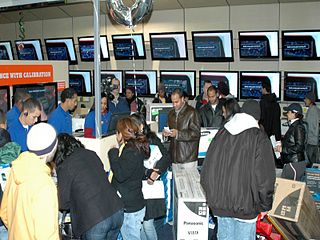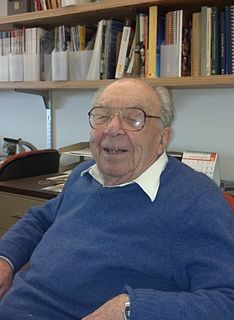
Electrical engineering is an engineering discipline concerned with the study, design and application of equipment, devices and systems which use electricity, electronics, and electromagnetism. It emerged as an identifiable occupation in the latter half of the 19th century after commercialization of the electric telegraph, the telephone, and electrical power generation, distribution and use.

Electronics comprises the physics, engineering, technology and applications that deal with the emission, flow and control of electrons in vacuum and matter. It uses active devices to control electron flow by amplification and rectification, which distinguishes it from classical electrical engineering which uses passive effects such as resistance, capacitance and inductance to control current flow.

Consumer electronics or home electronics are electronic equipment intended for everyday use, typically in private homes. Consumer electronics include devices used for entertainment, communications and recreation. Usually referred to as black goods due to many products being housed in black or dark casings. This term is used to distinguish them from "white goods" which are meant for housekeeping tasks, such as washing machines and refrigerators, although nowadays, these would be considered black goods, some of these being connected to the Internet. In British English, they are often called brown goods by producers and sellers. In the 2010s, this distinction is absent in large big box consumer electronics stores, which sell both entertainment, communication, and home office devices and kitchen appliances such as refrigerators. Radio broadcasting in the early 20th century brought the first major consumer product, the broadcast receiver. Later products included telephones, televisions, and calculators, then audio and video recorders and players, game consoles, personal computers and MP3 players. In the 2010s, consumer electronics stores often sell GPS, automotive electronics, video game consoles, electronic musical instruments, karaoke machines, digital cameras, and video players. Stores also sell smart appliances, digital cameras, camcorders, cell phones, and smartphones. Some of the newer products sold include virtual reality head-mounted display goggles, smart home devices that connect home devices to the Internet and wearable technology.

Roberto Mario "Robert" Fano was an Italian-American computer scientist and professor of electrical engineering and computer science at the Massachusetts Institute of Technology.
The EnOcean technology is an energy harvesting wireless technology used primarily in building automation systems, and is also applied to other applications in industry, transportation, logistics and smart homes. Modules based on EnOcean technology combine micro energy converters with ultra low power electronics, and enable wireless communications between batteryless wireless sensors, switches, controllers and gateways.
The Advanced Concepts Laboratory (ACL), formerly the Signature Technology Laboratory, is one of eight labs in the Georgia Tech Research Institute and one of three labs under the Sensors and Intelligent Systems directorate. ACL conducts research and development in four technical areas: electromagnetic materials and structures, electromagnetic apertures and scattering, optical and infrared physics and phenomenology, and secure information systems.

Naval Surface Warfare Center Crane Division is the principal tenant command located at Naval Support Activity Crane. NSA Crane is a United States Navy installation located approximately 35 miles southwest of Bloomington, Indiana and predominantly located in Martin County, but small parts also extend into Greene and Lawrence counties. It was originally established in 1941 under the Bureau of Ordnance as the Naval Ammunition Depot for production, testing, and storage of ordnance under the first supplemental Defense Appropriation Act. The base is named after William M. Crane. The base is the third largest naval installation in the world by geographic area and employs approximately 3,300 people. The closest community is the small town of Crane, which lies adjacent to the northwest corner of the facility.
The Research Laboratory of Electronics (RLE) at the Massachusetts Institute of Technology (MIT) was founded in 1946 as the successor to the famed MIT Radiation Laboratory of World War II. During the war, large scale research at the RadLab was devoted to the rapid development of microwave radar. Projects included physical electronics, microwave physics, electromagnetic properties of matter, and microwave communication principles. The "Rad Lab" designed almost half of the radar deployed in World War II, created over 100 different radar systems, and constructed $1.5 billion worth of radar.
CR-5000 is Zuken's design suite for electronics systems and printed circuit boards aimed at the enterprise market. It was developed to tackle complex design needs that involve managing the complete development and manufacturing preparation process on an enterprise-wide scale. CR-5000 offers relevant functionality for the design of complex and high-speed boards, addressing design challenges such as signal integrity and electromagnetic compatibility.
Stretchable electronics, also known as elastic electronics or elastic circuits, is a group of technologies for building electronic circuits by depositing or embedding electronic devices and circuits onto stretchable substrates such as silicones or polyurethanes, to make a completed circuit that can experience large strains without failure. In the simplest case, stretchable electronics can be made by using the same components used for rigid printed circuit boards, with the rigid substrate cut to enable in-plane stretchability. However, many researchers have also sought intrinsically stretchable conductors, such as liquid metals.
The French University of Egypt is a non-profit private university, established in 2002 at Cairo in El-Sherouk city. It is composed of three faculties: Business, Engineering, and Applied Languages. Each faculty is composed of different departments. All the diplomas offered by the university are in coordination with prestigious French universities like Paris III: Sorbonne University, the Nantes University, Haute Alsace (Mulhouse-Colmar) University and the Corse University. A convention with Paris VI University concerning the engineering school was also signed. The university is located in El-Shorouk city, 37 km (23 mi) from the center of Cairo. The university uses French (mainly), English and Arabic languages in teaching, and its graduates are able to use these three languages in any work domain related to their specialization.
The Standardization Administration of the People's Republic of China is the standards organization authorized by the State Council of China to exercise administrative responsibilities by undertaking unified management, supervision and overall coordination of standardization work in China. The SAC represents China within the International Organization for Standardization (ISO), the International Electrotechnical Commission (IEC) and other international and regional standardization organizations; the SAC is responsible for organizing the activities of the Chinese National Committee for ISO and IEC; the SAC approves and organizes the implementation of international cooperation and the exchange of projects on standardization.

JMAG is simulation software for the development and design of electrical devices. JMAG was originally released in 1983 as a tool to support design for devices such as motors, actuators, circuit components, and antennas.

Electronic engineering is an electrical engineering discipline which utilizes nonlinear and active electrical components to design electronic circuits, devices, integrated circuits and their systems. The discipline typically also designs passive electrical components, usually based on printed circuit boards.
Passivity is a property of engineering systems, most commonly encountered in analog electronics and control systems. Typically, analog designers use passivity to refer to incrementally passive components and systems, which are incapable of power gain. In contrast, control systems engineers will use passivity to refer to thermodynamically passive ones, which consume, but do not produce, energy. As such, without context or a qualifier, the term passive is ambiguous.
Electronics technicians help design, develop, test, manufacture, install, and repair electrical and electronic equipment such as communication equipment, medical monitoring devices, navigational equipment, and computers. They may be employed in product evaluation and testing, using measuring and diagnostic devices to adjust, test, and repair equipment. Electronics technicians may also work as sales workers or field representatives for manufacturers, wholesalers, or retailers giving advice on the installation, operation, and maintenance of complex equipment and may write specifications and technical manuals. Electronics technicians represent over 33% of all engineering technicians in the U.S. In 2009, there were over 160,000 electronics technicians employed in the U.S. Electronics technicians are accredited by organizations such as the Electronics Technicians Association (ETA), or International Society of Certified Electronics Technicians (ISCET).
The field of electrical and electronics engineering has grown to include many related disciplines and occupations.
Microwave engineering pertains to the study and design of microwave circuits, components, and systems. Fundamental principles are applied to analysis, design and measurement techniques in this field. The short wavelengths involved distinguish this discipline from electronic engineering. This is because there are different interactions with circuits, transmissions and propagation characteristics at microwave frequencies.






